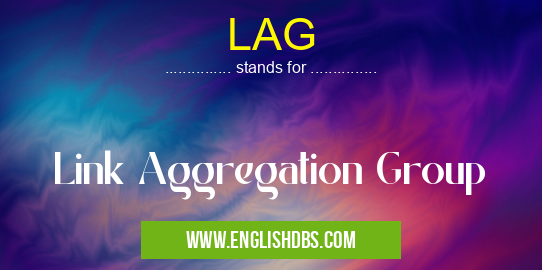What does LAG mean in TELECOM
Link Aggregation is a technique used to bond multiple physical interfaces together into a single logical interface. It allows the aggregation of multiple network connections in parallel for additional bandwidth and redundancy purposes. LAG can also be thought of as a way to increase the available throughput of one port by combining several physical ports into one single logical link. This helps provide higher throughputs, more network availability and throughput flexibility by allowing multiple links between switches to be grouped together as if they were one big pipe instead of individual pipelines.

LAG meaning in Telecom in Computing
LAG mostly used in an acronym Telecom in Category Computing that means Link Aggregation Group
Shorthand: LAG,
Full Form: Link Aggregation Group
For more information of "Link Aggregation Group", see the section below.
Link Aggregation Group (LAG)
Link Aggregation enables organizations to improve performance and reliability through increasing bandwidth, increasing uptime, and having the ability to move traffic across multiple connections if required. By utilizing this technology, organizations can increase their throughput while improving their network reliability and availability.
For instance, a typical LAN environment might have two switches connected together but each switch has only two 10/100MBps connections. With Link Aggregation, all four connections could be combined into one larger connection with greater data-transfer capabilities than otherwise possible in such an environment. In addition to improving speed and performance in such cases, Link Aggregation provides improved fault tolerance since traffic paths are automatically redirected when any given physical link fails or becomes congested.
Beyond using it for LAN environments, Link Aggregation can also be utilized for WAN connectivity solutions where dedicated networks require increased redundancy or high-speed throughput demand increases that cannot easily be handled by standard configurations. By bonding several lower capacity links together via software algorithms, an aggregate link with higher data handling capacity is created that allows easier access to remote locations without overloading existing lines or increasing latency due to outages or slowdowns on individual links in the bond.
In addition to providing increased speed and uptime options, Link Aggregation offers cost savings since fewer higher speed links need to be installed compared with separate lower capacity connections running concurrently throughout a system . Overall it is a tool which can enhance service level agreements through increased performance as well as cost savings due to its scalability features .
Essential Questions and Answers on Link Aggregation Group in "COMPUTING»TELECOM"
What is a Link Aggregation Group (LAG)?
A Link Aggregation Group (LAG) is a type of network connection that combines multiple physical ports into a single, logical link. It provides higher throughput than using a single link and more reliability by allowing multiple paths between two endpoints. LAGs are typically used for high-bandwidth applications or spanning large geographical distances.
What are the benefits of using a LAG?
The primary benefit of using a LAG is increased network bandwidth and improved reliability that comes from having multiple connections between two endpoints. Additionally, Link Aggregation Groups provide better traffic load balancing for applications that require it, such as VoIP and video streaming services. Having multiple links also allows different traffic types to be routed in different directions for better service levels.
How does Link Aggregation work?
Link Aggregation works by aggregating multiple physical ports together into one logical connection. This increases the maximum throughput and redundancy of the connection because it can utilize both links at once or failover to an alternative path if something goes wrong with one of them. Typically, this is done with Ethernet technology through switches that support IEEE 802.3ad or similar standards.
Do I need specialized hardware to use LAG?
Yes, you will need specialized hardware such as switches that support IEEE 802.3ad or similar standards in order to use Link Aggregation effectively. Additionally, you may need to install compatible drivers on your computers and other devices in order to properly configure the LAGs on each side of the connection.
How many physical ports can I combine in one LAG?
The exact number depends on the hardware being used but typically up to eight physical ports can be combined into one logical connection with a single LAG configuration.
Is there any limit on how far apart my devices must be when using a LAG?
No, there is no distance limitation when setting up a LAG. However, it is important to note that some vendors may have their own restrictions based on their own requirements and capabilities.
Can I use different types of cables for each port in my LAG?
Yes, you may be able to use different cables depending on your setup; however, it is important to make sure they all comply with IEEE 802.3ad standards if you want your setup to provide optimum performance.
What type of Ethernet cable should I use for best results?
For optimal performance from your AGP setup we recommend using Category 5E or Category 6 cabling which has been tested and certified compliant with IEEE 802.3ad standards.
